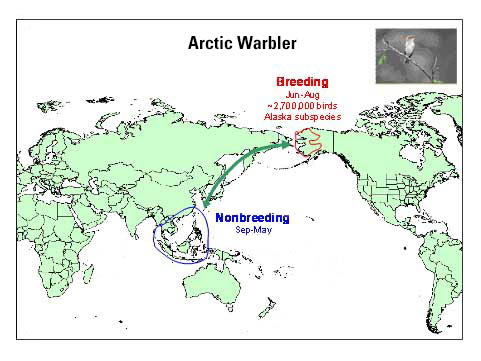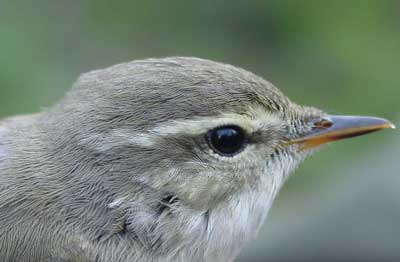Arctic Warbler, Phylloscopus borealis kennicotti
High-Priority Species ListWhere abundant, both adult and juvenile Arctic Warblers have been commonly captured and banded in mist-netting efforts aimed at estimating annual survival and productivity in Alaska. For example, from 1992–2001 a mist-netting station run in Denali National Park and Preserve (Denali NPP) as part of the Monitoring Avian Productivity and Survivorship program (MAPS) captured an average of approximately 27 adult and 12 juvenile Arctic Warblers per year. Similarly, a recent study of Arctic Warblers in the central Alaska Range by the Alaska Bird Observatory captured 40 adults in 2005. Thus, a crew of 2 technicians operating five MAPS stations placed in appropriate habitats could capture approximately 140 adult and 60 juvenile Arctic Warblers during a single breeding season in a single geographic area (e.g., Denali NPP). Multiplying this effort across five road-accessible areas with high densities of breeding Arctic Warblers (Dillingham, Nome, Denali NPP, Denali Highway, and c. Brooks Range), five crews could capture in a single breeding season approximately 700 adult and 300 juvenile Arctic Warblers for sampling of actively shedding Asian H5N1.
Such sampling would not only provide 95% power of detecting Asian H5N1 in approximately 1.5% of the population of adults and juvenile Arctic Warblers for each geographic area, but also ensure robust sampling of adults returning from throughout the species wintering range in southeast Asian and Indonesia. Furthermore, incidental capture of Gray-cheeked Thrushes, Eastern Yellow Wagtails, Bluethroats, and Northern Wheatear would help achieve sampling goals for early detection of Asian H5N1 for these species in Alaska. Incidental captures of Gray-cheeked Thrush in particular would likely result in sampling of = 200 breeding adults and juveniles at no additional costs in sampling.
No. of samples: 700 adults, 300 juveniles
Sampling locations: Denali NPP, Denali Highway, Nome, Dillingham, central Brooks Range
Sampling timeframe: 10 June-8 August
Sample demographics: Adults and juveniles, males and females
Methods of capture: Live capture, release
Other targeted species: Eastern Yellow Wagtail; Bluethroat; Northern Wheatear; Gray-cheeked Thrush; Swainson’s Thrush; Orange-crowned, Blackpoll, and Wilson’s warblers; American Tree, Fox, and White-crowned sparrows; Common and Hoary redpolls (target species for surveillance of Asian H5N1 included in bold)
Contact: Steven M. Matsuoka
Togiak NWR
U.S. Geological Survey
Contact: Colleen M. Handel
Bureau of Land Management’s Northern Alaska District
National Park Service
Contact: Carol McIntyre
Alaska Bird Observatory
Institute for Bird Populations

Ranking Score: 17.0
Asian H5N1 ranking criteria for Arctic Warbler, Phylloscopus borealis kennicotti.
Total of partial contact with Asia1 |
Contact with known "hot spot"2 |
Habitat used in Asia3 |
Pop. in Alaska4 |
Can samples be obtained? |
Score |
5.0 |
2.0 |
3.0 |
4.0 |
3.0 |
17.0 |
Winters in Myanmar, Thailand, Philippines south to Andaman Is, Malay Penin, and Indonesia east to Moluccas |
s.e. Asia and Indonesia |
Terrestrial. Wooded habitats, cultivated areas, grasslands, gardens, and mangroves |
Approximately 2,700,000 |
Most abundant breeding bird in many locations. Very easy to capture during breeding and migration. Already capture 30-45 birds per year during breeding |

